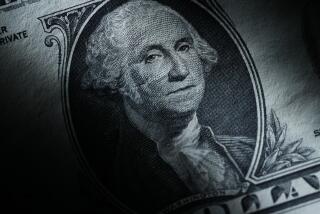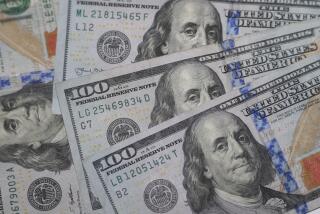Year at Point of Low Return for Income-Conscious Investors : Investment: Interest rates for savers are not as rewarding as a decade ago, but taxes and inflation aren’t taking as big a bite.
- Share via
NEW YORK — The financial menu looks pretty skimpy as income-conscious investors consider where to put their money for a new year and a new decade.
No matter how far in time you are willing to extend yourself, alluring returns on certificates of deposit, bonds and other interest-bearing investments are hard to find these days.
Certainly, you are unlikely to come across anything now that matches the two-digit yields on low-risk securities that were so commonly available in the early 1980s.
But inflation has also declined in recent years, and so has the maximum rate at which the federal government taxes most people’s interest income. So, in the view of many analysts, the “real” returns offered now aren’t as stingy as they might look.
Suppose as 1990 begins that you can get a yield of 8.3% from a CD or money-market mutual fund. If your income tax bracket is 28%--the top rate that applies to most savers and investors--you have a return of 6% left over after Uncle Sam takes his cut.
After taking into account consumer inflation in the 4% to 5% annual range, you still emerge with a positive return.
On paper at least, that beats the results you might have achieved at a nominal interest rate of, say, 13% a decade ago, when inflation and taxes together would have left you actually in the red.
Of course, the current returns that savers and investors can get are only part of the story. The ideal investment choice also must keep looking good through the future ups and downs of inflation and interest rates.
Right now, many analysts are predicting at least a modest decline in interest rates over the next several months. That would argue in favor of longer-term investments such as CDs or bonds rather than short-term options such as money market funds.
Unfortunately, interest rates at present are such that you get paid little or nothing for making that kind of longer-term commitment.
A recent tally by the Bank Rate Monitor showed three-month CDs yielding an average of 7.87%; two-year CDs 7.71%, and five-year CDs 7.73%.
This is known in financial circles as a flat, or slightly “inverted,” yield curve, and it is abnormal although by no means unprecedented in modern history.
The yield curve has been out of kilter for more than a year now. But some analysts think it is slowly beginning to resume a more orthodox shape.
For now, the Value Line Investment Survey, the nation’s largest independent investment advisory service, recommends keeping your options open by sticking mainly with short-term commitments. “A bit more patience,” the firm urges, “a wait until the long rate offers more of a yield advantage to warrant the added risk.”
Staying short term, of course, also gives you protection should interest rates pull a surprise by heading higher. In that event, yields on vehicles such as money market funds would stand to move up as well.
What if interest rates should neither rise nor fall, but hover around present levels for some indeterminate period?
That would create few opportunities for investors to pull off heroic coups of market timing. But it would leave enough goodies to go around that hardly anyone need be entirely dissatisfied.
“The sideways scenario isn’t bad for either camp,” observed Edward Yardeni, economist at the Wall Street firm of Prudential-Bache Securities.
More to Read
Inside the business of entertainment
The Wide Shot brings you news, analysis and insights on everything from streaming wars to production — and what it all means for the future.
You may occasionally receive promotional content from the Los Angeles Times.










